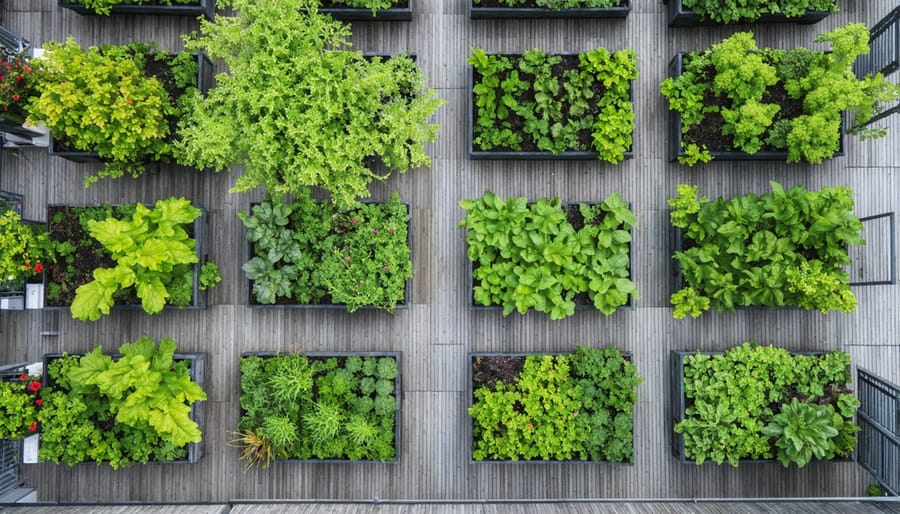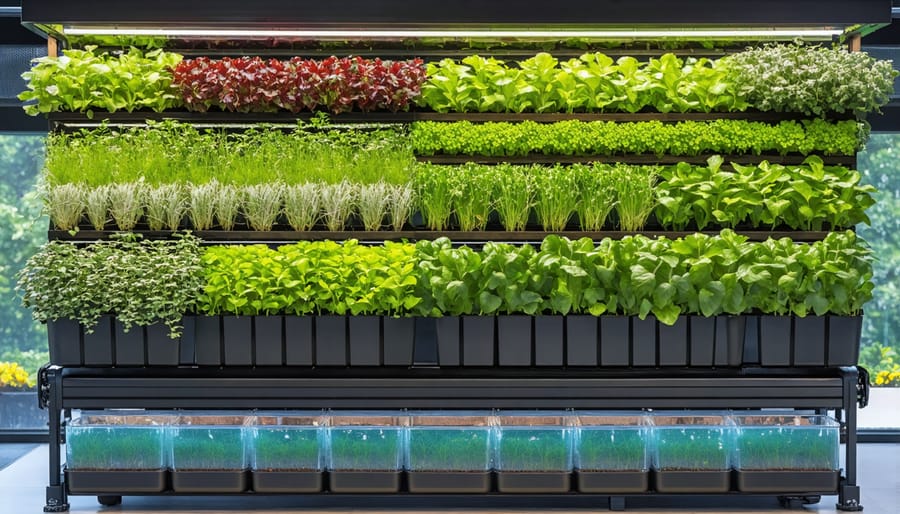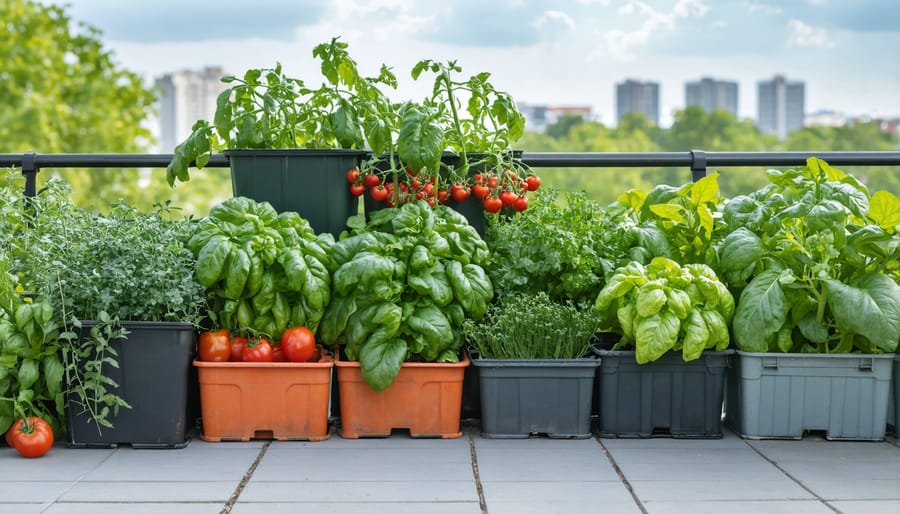Transform your unused rooftop into a thriving urban oasis by integrating sustainable urban farming practices that maximize limited space and resources. Install modular raised beds along sturdy load-bearing walls, creating dedicated zones for herbs, vegetables, and pollinator-friendly flowers. Position taller plants like tomatoes and trellised cucumbers on the north side to prevent shading shorter crops, while using wind-resistant containers to anchor delicate seedlings against urban gusts. Harness vertical space with innovative growing systems – stack strawberry towers, mount living walls, and suspend hanging baskets from pergolas to multiply your growing area threefold. Beyond fresh produce and visual appeal, rooftop gardens naturally cool buildings, reduce stormwater runoff, and create vital green spaces in concrete landscapes. With proper planning and smart design choices, even the smallest urban rooftop can become a productive ecosystem that connects city dwellers with nature’s rhythms while contributing to a more sustainable future.
Planning Your Urban Rooftop Oasis
Safety First: Building Requirements and Permits
Before starting your rooftop garden adventure, it’s crucial to ensure your building can safely support your green oasis. First, consult a structural engineer to assess your roof’s load-bearing capacity. Most residential roofs can support 30-40 pounds per square foot, but this varies depending on building age and construction.
Contact your local building department to understand permit requirements. Many cities require specific permits for rooftop gardens, especially if you’re planning structural modifications or installing irrigation systems. You’ll likely need to submit detailed plans showing weight distribution, drainage solutions, and safety barriers.
Remember to check building codes regarding railing heights (typically 42 inches minimum) and emergency access requirements. Install proper waterproofing membranes to protect your building’s structure, and ensure your drainage system prevents water from pooling. Consider wind exposure at roof level – you may need to secure containers and install windbreaks.
Keep documentation of all inspections, permits, and modifications. Many building insurance policies require this information, and it’s invaluable if you ever decide to sell your property.
Mapping Your Garden Layout
Before you start planting, taking time to map out your rooftop garden layout will maximize your growing space and ensure the best possible yields. Start by measuring your available area and creating a simple sketch on graph paper, noting any fixed elements like vents, access points, or utilities that need to remain accessible.
Consider the sun’s path across your roof throughout the day. Map out which areas receive full sun (6+ hours), partial sun (4-6 hours), or shade. This information will be crucial for placing plants in their ideal growing conditions. Remember that taller plants should typically be positioned on the north side to prevent shading shorter ones.
Divide your garden into manageable zones based on plant needs and maintenance requirements. Group plants with similar water needs together to make irrigation more efficient. Create clear pathways between planting areas – you’ll need about 2 feet of space to move comfortably and tend to your plants.
When planning container placement, think about weight distribution. Larger containers should be placed near load-bearing walls or over structural support points. Consider using lightweight containers and growing medium to reduce the overall load on your roof.
Include dedicated spaces for essential garden elements like a small potting station, tool storage, and a compost bin if permitted. Don’t forget to plan for vertical growing opportunities – trellises and wall-mounted planters can dramatically increase your growing space while keeping pathways clear.
Sketch different layout options before settling on your final design. This planning phase will help you avoid costly mistakes and create a more organized, productive garden space that’s easy to maintain throughout the growing season.


Smart Container Solutions for Urban Harvests
Self-Watering Systems That Save Time
For busy urban gardeners, maintaining a rooftop garden shouldn’t mean being tied to a strict watering schedule. Modern efficient irrigation solutions have made it easier than ever to keep your plants thriving while saving both time and water.
Self-watering containers are a game-changer for rooftop gardens. These clever systems feature a water reservoir at the bottom that allows plants to draw up moisture as needed through capillary action. Simply fill the reservoir once or twice a week, and your plants will stay perfectly hydrated without daily attention.
Automated drip irrigation systems offer another fantastic solution. These can be connected to a timer and customized to deliver precise amounts of water directly to your plants’ roots. Many modern systems even include smart controllers that adjust watering schedules based on weather conditions and soil moisture levels.
For those interested in sustainable practices, consider installing a rainwater harvesting system. Collection barrels can capture rainfall from nearby structures, providing a free water source for your garden. Combine this with moisture-retaining materials like coconut coir or water-storing crystals in your soil mix to maximize water efficiency.
Remember to group plants with similar water needs together and use mulch to reduce evaporation. These simple strategies, combined with modern self-watering systems, will help your rooftop garden thrive with minimal daily maintenance.
Space-Maximizing Container Choices
When space is at a premium on your rooftop garden, choosing the right containers can make all the difference. Self-watering containers are excellent space-savers that require less frequent maintenance and provide consistent moisture to your plants. These smart solutions come in various sizes and can accommodate everything from herbs to small fruit trees.
Vertical growing systems are game-changers for rooftop gardens. Consider installing wall-mounted planters or pocket gardens, which transform blank walls into lush growing spaces. Stackable containers and tiered planters are particularly effective, allowing you to grow multiple plants while maintaining a small footprint. Many gardeners have found success with recycled pallet gardens, which can be mounted vertically and are perfect for growing shallow-rooted plants like lettuce and strawberries.
For those really tight on space, hanging baskets and rail planters that attach to railings or balustrades offer additional growing areas without taking up precious floor space. Look for lightweight materials like fiber-glass or high-grade plastic, which are easier to manage and won’t overload your roof’s weight capacity.
Don’t overlook the potential of fabric grow bags – they’re lightweight, affordable, and can be arranged creatively to maximize space. When not in use, they fold flat for storage. For larger plants, consider square or rectangular containers rather than round ones, as they fit together more efficiently and make better use of corner spaces.
Remember to ensure all containers have adequate drainage holes and are elevated slightly off the surface to prevent water damage to your roof. Using pot feet or risers creates necessary air circulation and helps maintain healthy root systems.
Weather-Smart Gardening Strategies
Wind Protection Techniques
Strong winds can be a significant challenge for rooftop gardeners, but there are several effective ways to protect your plants. Installing windbreaks is your first line of defense – try positioning sturdy trellises, decorative screens, or even portable garden walls around your most vulnerable plants. These barriers should be semi-permeable, allowing some air to flow through while reducing wind intensity.
Strategic plant placement also plays a crucial role. Place taller, hardier plants on the windward side to shield more delicate specimens. Group plants together in clusters rather than isolating them, as this creates natural wind protection and maintains humidity levels.
For container gardens, use heavier pots or secure lighter ones with garden twine or brackets. Consider installing permanent planters along the edges of your rooftop – these can serve as both windbreaks and growing spaces. Adding a layer of mulch to your containers helps retain moisture and keeps soil from being blown away.
Temporary solutions like horticultural fleece or clear plastic shields can protect plants during particularly windy periods. Remember to remove these covers during calm weather to prevent overheating. For climbing plants, ensure trellises and supports are firmly anchored and provide additional tie points to prevent wind damage to stems and foliage.
Managing Sun and Heat Exposure
Managing sun exposure and heat on a rooftop garden requires thoughtful planning and clever solutions. Rooftops can experience temperatures up to 20°F higher than ground level, making temperature control essential for your plants’ survival. Start by mapping your garden’s sun patterns throughout the day – some areas might receive intense direct sunlight while others create pockets of shade.
Consider installing shade cloth or pergolas to protect sensitive plants during peak sun hours. These structures can reduce temperature and light intensity by 30-60%, creating a more hospitable environment for your garden. Lightweight, removable shade sails are perfect for renters or those seeking flexible solutions.
Container selection plays a crucial role in heat management. Light-colored pots reflect sunlight and keep root systems cooler, while self-watering containers help maintain consistent moisture levels. Adding a layer of mulch around your plants can reduce water evaporation and keep soil temperatures stable.
Create microclimates by positioning taller plants to shade more delicate ones. Heat-loving vegetables like tomatoes and peppers can thrive in full sun areas, while leafy greens appreciate afternoon shade. Remember to water early in the morning or evening when temperatures are cooler, allowing plants to absorb moisture efficiently before the day’s heat sets in.
Best Plants for Rooftop Success
Edible Options That Love Height
When it comes to best vegetables for container growing, rooftop gardens offer the perfect opportunity to grow an abundance of edible plants that thrive in sunny, elevated conditions. Tomatoes are natural champions in rooftop settings, especially cherry and determinate varieties that won’t grow too tall. Their deep roots help them withstand wind while soaking up the abundant sunshine.
Peppers, both sweet and hot varieties, absolutely love the warmth that rooftop environments provide. They’re compact growers that produce impressive yields in containers. Mediterranean herbs like rosemary, thyme, and sage are particularly well-suited to rooftop conditions, as they naturally prefer hot, sunny spots with excellent drainage.
Bush beans and compact cucumber varieties are excellent choices that provide generous harvests without taking up too much space. For leafy greens, try heat-tolerant varieties of lettuce, Swiss chard, and kale, which can be planted in partial shade created by taller plants.
Don’t forget about root vegetables! Radishes, carrots, and beets grow beautifully in deep containers and add variety to your rooftop harvest. For year-round flavor, maintain a collection of hardy herbs like chives and oregano, which will return season after season with minimal care.
Remember to group plants with similar water needs together to make maintenance easier and more efficient. With proper planning, your rooftop can become a thriving edible paradise.

Climate-Hardy Ornamentals
Selecting ornamental plants for your rooftop garden requires careful consideration of their resilience to wind, sun exposure, and temperature fluctuations. Succulents are excellent choices, with varieties like Sedum, Sempervivum (hen and chicks), and Echeveria thriving in these challenging conditions while adding visual interest through their diverse shapes and colors.
Ornamental grasses prove particularly successful in rooftop settings. Mexican Feather Grass and Blue Fescue wave gracefully in the breeze while requiring minimal maintenance. Their strong root systems help them anchor well in containers, and they provide year-round visual appeal.
Drought-resistant flowering plants can add vibrant splashes of color to your rooftop oasis. Consider Russian Sage, which produces lovely purple spikes throughout summer, or Lantana, offering clusters of multi-colored blooms that attract butterflies. Lavender not only provides beautiful purple flowers but also releases a soothing fragrance when the wind rustles through its stems.
For vertical interest, try growing climbing roses specifically bred for container gardens. Varieties like ‘Climbing Iceberg’ or ‘Fourth of July’ can be trained on trellises while withstanding rooftop conditions. Mediterranean herbs like rosemary and sage double as ornamentals, offering both aesthetic appeal and culinary value while thriving in sunny, exposed locations.
Remember to group plants with similar water needs together and use deep containers with good drainage to ensure your ornamental selections flourish in their rooftop home.
Creating an urban rooftop garden is more than just a rewarding hobby – it’s a meaningful step toward sustainable living and personal well-being in our concrete jungles. Throughout this guide, we’ve explored the essential aspects of transforming your rooftop into a thriving green oasis, from ensuring structural safety to selecting the perfect plants for your space.
Remember that success in rooftop gardening comes from careful planning, understanding your environment, and starting small. Begin with a few container plants, learn from your experiences, and gradually expand your garden as your confidence grows. The challenges of wind, weight restrictions, and varying weather conditions might seem daunting at first, but they’re all manageable with the right approach and preparation.
Your rooftop garden can be whatever you envision – a peaceful retreat, a productive vegetable patch, or a vibrant flower garden that attracts butterflies and birds. The possibilities are endless, and the benefits extend far beyond your harvest. You’ll enjoy fresher air, reduced energy costs, and the satisfaction of growing your own food while contributing to urban biodiversity.
Don’t let limited space or urban living hold you back from experiencing the joys of gardening. Take that first step today – whether it’s researching local regulations, consulting with a structural engineer, or picking up your first few containers. Your future garden paradise awaits, and the journey is just as rewarding as the destination.




